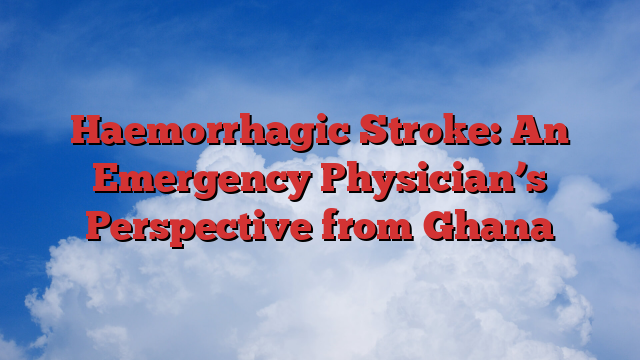![]()
As an emergency physician in Ghana, I often encounter patients with a variety of medical emergencies. Among these, haemorrhagic stroke stands out due to its sudden onset and devastating impact. In this blog post, I will delve into the intricacies of haemorrhagic stroke, illustrated by a realistic case scenario, and highlight the challenges and approaches to managing this critical condition in an emergency setting in Ghana.
Understanding Haemorrhagic Stroke
Haemorrhagic stroke occurs when a blood vessel in the brain ruptures, leading to bleeding within or around the brain. This type of stroke accounts for approximately 13% of all strokes but is responsible for a significant proportion of stroke-related morbidity and mortality. Haemorrhagic strokes can be classified into two main types: intracerebral haemorrhage (ICH) and subarachnoid haemorrhage (SAH).
- Intracerebral Haemorrhage (ICH): This occurs when an artery in the brain bursts, flooding the surrounding tissue with blood. It is often associated with high blood pressure, arteriovenous malformations, or head trauma.
- Subarachnoid Haemorrhage (SAH): This involves bleeding into the space between the brain and the surrounding membrane (subarachnoid space). It is commonly caused by the rupture of an aneurysm.
Case Scenario: A Realistic Encounter
Let’s consider the case of Mr. Kwame, a 58-year-old farmer from a rural village in Ghana. Mr. Kwame was brought to the emergency department by his family after suddenly collapsing while working in his field. According to his relatives, he had been complaining of a severe headache for the past few days, which he attributed to the stress of the planting season. On the day of his collapse, he had complained of a thunderclap headache, nausea, and weakness on his right side.
Initial Assessment and Diagnosis
Upon arrival, Mr. Kwame was unresponsive with a Glasgow Coma Scale (GCS) score of 8/15. His blood pressure was 210/120 mmHg, and he had a noticeable right-sided hemiplegia. Given the history and clinical presentation, haemorrhagic stroke was highly suspected.
- Immediate Imaging: A non-contrast CT scan of the head was performed, which revealed a large intracerebral haemorrhage in the left hemisphere with significant midline shift, indicating increased intracranial pressure (ICP).
- Laboratory Tests: Blood tests were conducted to evaluate his coagulation status, complete blood count, and renal function.
Emergency Management
Managing haemorrhagic stroke requires a multifaceted approach aimed at stabilizing the patient, controlling the bleeding, and preventing secondary brain injury.
- Stabilization:
- Airway Management: Mr. Kwame was intubated to protect his airway due to his decreased level of consciousness.
- Blood Pressure Control: Intravenous antihypertensive medications, such as labetalol, were administered to gradually reduce his blood pressure to a target range of 140-160 mmHg systolic.
- Controlling the Bleeding:
- Reversal of Anticoagulation: If the patient was on anticoagulants, reversal agents would be administered. However, in Mr. Kwame’s case, there was no history of anticoagulant use.
- Surgical Intervention: Given the size of the haemorrhage and the associated midline shift, a neurosurgical consultation was urgently requested. Decompressive craniectomy was considered to relieve the pressure.
- Preventing Secondary Brain Injury:
- ICP Management: Measures to control ICP included elevating the head of the bed to 30 degrees and administering mannitol or hypertonic saline.
- Seizure Prophylaxis: Antiepileptic drugs were administered to prevent seizures, which are common in patients with intracerebral haemorrhage.
Challenges in the Ghanaian Context
Managing haemorrhagic stroke in Ghana presents unique challenges, particularly in rural areas. These challenges include limited access to advanced imaging modalities, shortage of neurosurgical expertise, and delays in transportation to tertiary care centers. In Mr. Kwame’s case, the nearest tertiary care center with neurosurgical capabilities was several hours away, which posed a significant hurdle.
- Resource Limitations: In many rural hospitals, CT scanners may not be readily available, and even if they are, the costs can be prohibitive for many patients. Additionally, medications and surgical interventions may be limited.
- Transportation and Infrastructure: Poor road conditions and lack of ambulance services can delay timely access to specialized care. This underscores the importance of having well-equipped and staffed district hospitals that can provide initial stabilization and management.
Long-Term Management and Rehabilitation
Survivors of haemorrhagic stroke often face prolonged rehabilitation and a high risk of recurrent strokes. Mr. Kwame’s long-term management plan included:
- Rehabilitation Services: Physical therapy, occupational therapy, and speech therapy were crucial for his recovery. Unfortunately, access to these services is often limited in rural Ghana.
- Risk Factor Management: Strict blood pressure control, smoking cessation, and managing other comorbidities such as diabetes were emphasized to reduce the risk of recurrence.
- Community Support: Educating the community and family members about stroke recognition and the importance of timely medical intervention was essential.
Conclusion
Haemorrhagic stroke is a life-threatening condition that requires prompt and effective management. As an emergency physician in Ghana, the challenges are significant, but with timely intervention and a comprehensive approach, outcomes can be improved. Mr. Kwame’s case highlights the critical importance of rapid diagnosis, aggressive management, and the need for improved healthcare infrastructure in rural areas.
By addressing these challenges and fostering collaboration among healthcare providers, we can enhance the care of patients with haemorrhagic stroke in Ghana, ultimately saving lives and improving the quality of life for stroke survivors.

